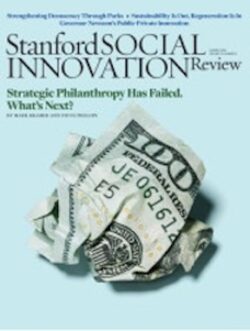Seeming to despair of creating anything of lasting value from philanthropy understood as a free-standing activity—and shifting to what turns out to be little more than another Democratic Party get-out-the vote effort, of the sort already very much in evidence in today’s political philanthropy.
Every half-dozen years or so, Mark Kramer—co-founder and board chair of FSG, a major philanthropy consulting firm—comes out with a major new framework for pursuing “strategic philanthropy.” The latest version was announced in a cover story for the Summer 2024 Stanford Social Innovation Review entitled “Where Strategic Philanthropy Went Wrong.” A cynic might suggest that a more appropriate title would be “Where Strategic Philanthropy Went Wrong … By Listening to Us in the Past.”
There’s certainly nothing wrong with changing one’s mind if the facts warrant it, as Kramer critic Phil Buchanan noted in response. But Kramer—and his ever-changing cast of co-authors—have a unique way of doing so. First, they claim to have discovered a totally new and more productive way to “do” philanthropy. Skeptical observers point out that their approach is neither new nor all that productive. Kramer et al. then turn around a few years later and denounce their own earlier approach as a mistake, typically for the (unacknowledged) reasons the critics had already suggested. But now, Kramer et al.insist, they’ve discovered a new new way. Rinse and repeat.

I’ll leave it to thoughtful observers like Buchanan, Cynthia M. Gibson and William M. Dietel, and Ruth McCambridge to deal with the operational deficiencies of Kramer’s bewilderingly kaleidoscopic approach to philanthropy. Though I should say that, as a foundation program officer, I suffered under the dictates of Kramer’s first grand proclamation about strategic philanthropy. In an article he co-authored in 1999 with Michael E. Porter and published in the Harvard Business Review, they insisted that foundations should view themselves as businesses, competing with each other to produce “unique value.” For years afterward, tough-minded corporate types on foundation boards were swatting program officers upside their mushy heads with that issue of HBR. (Though Kramer himself would later renounce it for deficiencies that had been evident from the beginning to anyone who had actually worked at a foundation.)
I’m more concerned here, though, with the political implications of the latest Kramer take, this time co-authored with Steve Phillips. Phillips is a progressive writer and philanthropist, a columnist for The Nation and The Guardian, and a central figure in the founding of the left’s Democracy Alliance, Center for American Progress, and ProPublica. As one might expect from his new co-author’s credentials, Kramer Take Four (Five? Six?) has now shifted dramatically toward active engagement in politics of a distinctly left-wing variety.
Despair
Indeed, they seem to despair of creating anything of lasting value from philanthropy understood as a free-standing activity. In spite of a ninefold increase in charitable giving over the past 40 years, they lament, “there has been no discernible progress on our nation’s urgent challenges, including poverty, chronic disease, educational disparities, housing shortages, racial inequity, and climate.” Instead, “philanthropy’s efforts on many issues seemed to be overwhelmed by the scale and immediate effects of government laws, policies, and court decisions.” In their view, “conservative politicians and judges, together with corporate lobbyists, have been astonishingly successful at undoing decades of social progress.”
Like all good strategic philanthropists from John D. Rockefeller on down, Kramer and Phillips believe they should seek to address the root causes of problems, not just put charitable band-aids on them. But now “there’s abundant evidence that philanthropy cannot solve societal problems on a national scale.” Poverty, for instance, “is the direct result of government policy and corporate behavior shaped by a history of structural racism.”
It turns out that “the primary root cause behind every social and environmental issue facing the United States is the failure of our political process to ensure the well-being of our entire population.” This can only be addressed by shifting charitable giving away from well-intentioned but (in light of a fundamentally unjust political system) futile free-standing program funding, into addressing “the dire need for a functioning, representative, multiracial democracy.”
What might such an undertaking look like? Well, if we were expecting some grand revolutionary movement after this build-up, we’d be sorely disappointed. Because it turns out to be little more than another Democratic Party get-out-the vote effort, of the sort already very much in evidence in today’s political philanthropy.
Stacey Abrams in Georgia showed the way, according to Kramer and Phillips. Her New Georgia Project managed to increase “the turnout by voters of color by almost 50 percent,” thus “electing Democrats Raphael Warnock and Jon Ossoff to the US Senate,” enabling the “Democrats to retain control of the US Senate,” in turn securing the Inflation Reduction Act of 2022. That act added $500 billion to public spending, which, as Kramer and Phillips note, is “[n]ot bad for an organization with an annual budget of just $13 million.”
If just “5 percent of foundations’ annual funding—$5 billion—were dedicated to voter engagement” on the Abrams model, Kramer and Phillips argue,“it would transform elections in the United States and enable the start of a policy agenda at all levels of government that would actually deliver, on a national scale, many of the outcomes funders try so hard to achieve through nonprofit programs.” (Of course, if a mere 5% could have such magical effects, imagine what 30%, 40%, or 50% could accomplish!)
As for those pesky legal restrictions on political activity by foundations, Kramer and Phillips maintain that they were imposed by anti-Black conservative members of Congress in the Tax Reform Act of 1969. An effective countermeasure, they argue, would be for foundations to deploy their “self-defense” exception to the lobbying ban to “lobby for the right to lobby in the public interest,” thus opening the door completely to engagement in politics.
Actually, it’s a bit too general to say that Kramer and Phillips seek a philanthropy dedicated to a Democratic Party get-out-the-vote (GOTV) effort. For even the Democratic Party is riddled with patriarchal racism. As the authors note, “White men comprise 31 percent of the American population and just 23 percent of Democratic voters, but they control 90 percent of Democratic politics and progressive advocacy.” Better to follow Phillips’ advice in his book Brown Is the New White: stop “focusing nearly all voter outreach on white swing-state voters,” because there’s now “a new majority: voters of color and progressive white voters together make up 51% of all eligible voters.”
Caution
A bit of caution might be wise, though, before philanthropy completely evacuates its assigned sphere in order to become a left-wing Democratic lobbying and GOTV group. First, as Buchanan points out, philanthropy can in fact claim a number of successes without having had to resort to full-scale political warfare: vaccines and other major medical advances, marriage equality, land conservation, criminal-justice reform, local responses to the COVID pandemic, and so forth. These accomplishments are barely acknowledged by Kramer and Phillips, Buchanan rightly notes.
And before we dismiss as futile all philanthropic spending because only government can solve our problems, it would be wise to ask: what was the aforementioned government doing throughout those years of philanthropic futility? Was it loitering on the sidelines, waiting for philanthropy to remind it to spend money?
Not exactly. In fact, as Joseph Bessette pointed out recently in the Claremont Review of Books, from 1932 to 2012, “federal spending rose from just over $5 billion to $3.8 trillion,” with “domestic spending rising from $2.3 billion to $2.8 trillion.” Over that time, our population grew by two and a half times, while spending (adjusted for inflation) was 45 times higher, with domestic spending 73 times higher. Between 2012 and 2022, Bessette continues, “total federal spending increased another 70%, from $3.8 trillion to $6.5 $trillion.” And this is before we throw in state and local spending.
Kramer and Phillips are not unaware that government has been spending a dollar or two on the same problems that have frustrated philanthropy. They cite President Lyndon Johnson’s War on Poverty in the 1960s as an example of what government can do, with legislation “that transformed American schools, launched Medicare and Medicaid, and expanded housing subsidies, urban development programs, employment and training programs, food stamps, and Social Security and welfare benefits,” more than tripling “real federal expenditures on health, education, and welfare.”
Did that all spending just vanish after the 60s, waiting for Kramer and Phillips to urge us to resume it? Of course not. Even cost-conscious Presidents Richard Nixon and Ronald Reagan couldn’t make a dent in the proliferation of federal domestic programs or the explosion in government spending after the Great Society. Other than Johnson’s Office of Economic Opportunity, no other program of the War on Poverty was eliminated, and most have grown many times over since then.
Kramer and Phillips betray their neglect of already-established government programs in their criticism of Teach for America, the private-sector program recruiting top college graduates for teaching stints in inner-city schools. “At its peak in 2013, … Teach for America provided teachers for roughly 400,000 students annually, but those students represented only 2 percent of the 20 million low-income students entitled to free school lunches.”
So what were non-TFA students doing meanwhile—playing stickball in the streets? No, they were being “educated” by immensely expensive government schools, in cities that haven’t seen a Republican administration since FDR’s time. Such schools, furthermore, are entirely in thrall to the teachers’ unions that provide the foot soldiers for the most progressive faction of the Democratic Party. Teach for America failed to make more headway because reform has been fiercely resisted by an education establishment thoroughly imbued with the progressive ideology now championed by Kramer and Phillips.
This isn’t the place for a detailed critique of government spending—a critique, by the way, that hasn’t been made for quite some time by any but the most libertarian outliers within the Republican Party. Suffice it to say that philanthropy shouldn’t abandon its current role in order to plunge into politics without first telling us how foundation lobbying and voter mobilization will somehow bring about improvements that have eluded trillions of dollars in past and present government expenditures.
Impairment
Kramer and Phillips might also consider how their proposal will play within the Democratic Party itself. Its current team of campaign consultants—however disproportionately white and male—seems to have been doing a pretty good job winning Congressional and presidential federal elections since the Reagan era. Their success has been based on the understanding that it’s necessary to attract at least some white male votes within the swing states, where Electoral College outcomes are often decided. They pursue that strategy by sanding off some of the sharpest progressive edges of the Democratic coalition.
But as John B. Judis, Ruy Teixeira, and other Democratic thought leaders argue, their ability to do so has been seriously impaired by progressive activist groups that insist on getting their own ideological way, without regard to practical political outcomes. Daniel Schlozman and Sam Rosenfeld put it this way in The Hollow Parties: The Many Pasts and Disordered Present of American Party Politics: the growing role played by activist nonprofits “able to engage in open lobbying and electioneering … worsened, rather than mitigated, Democrats’ difficulties in setting priorities, forging cohesive projects, and building meaningful connections with ordinary Americans in their communities.”

Progressive foundations are foremost among those insistent, uncompromising ideological activists. They sit atop vast sums of free-floating cash they did nothing to earn or attract; they are almost completely insulated from urgent external demands or consequential criticisms; their mission statements often focus obsessively on the utopian goal of dismantling structural racism and white supremacy; and they’re increasingly staffed by young, college-educated social-justice warriors who can’t imagine a world where diversity, equity, and inclusion aren’t the central concerns. In short: they’re ill-equipped to practice a democratic political art demanding flexibility, forbearance, and compromise.
Although Judis and Teixeira were among the first to predict the emergence of Phillips’ new majority—“voters of color and progressive white voters” who now “make up 51% of all eligible voters”—they have more recently warned that unrelenting focus on those voters and neglect of white males is a serious threat to the future of the Democratic Party. They are not likely to welcome Kramer’s and Phillips’ proposed massive infusion of new progressive philanthropic dollars into the single-minded pursuit of the “new majority.”
It’s also worth noting that the Kramer and Phillips approach takes us in precisely the opposite direction of another new and compelling philanthropic trend, namely, the search for “common ground,” now featured prominently in The Chronicle of Philanthropy. However quixotic that effort may be, at least it offers a sober alternative to the view that philanthropy should just keep funding endless trench warfare between ideological extremes, until one or the other achieves a pyrrhic victory amidst the national political rubble.
Meanwhile, however, there’s a more interesting, and somewhat contradictory, secondary story line in “Where Strategic Philanthropy Went Wrong.” Kramer and Phillips describe their newest new approach as “empowerment philanthropy.” They celebrate foundation efforts to seek out and support groups that run innovative programs for local, community-based uplift, “providing funding in ways that foster self-determination and enhance beneficiaries’ sense of agency.”
Anyone familiar with the work of the American Enterprise Institute’s “mediating structures” project in the 1970s will recognize this approach from Peter Berger’s and Richard John Neuhaus’s influential monograph To Empower People. We at The Giving Review have championed Bob Woodson’s efforts to strengthen the mediating structures of poor communities, for all the reasons offered by Kramer and Phillips. But this previous work (true to form, according to Buchanan) is not acknowledged. Perhaps it’s inconceivable that conservatives—dedicated solely to “undoing decades of social progress”—could have earlier proposed an approach to poverty that focused on the ability of low-income grassroots groups to define and solve their own problems.
At any rate, it’s hard to see how, in the world of Kramer and Phillips, such small, local efforts could make much difference. After all, they’re engaged in a “battle for the future of our country against those who use government to protect their own power and privilege at everyone else’s expense” and whose “tools are control, suppression, and false narratives.” To wage that battle, only massive philanthropic investment in progressive politics seems likely to succeed.
Damaging
The editors of The Giving Review have long warned against the politicization of charity, in part because we believe that popular support for the sector rests on the faith (however naïve and antiquated it may seem to sophisticated experts) that it addresses immediate human needs in concrete and reliable ways. We have warned against the tendencies of some foundations to edge ever closer to the border with politics, in the name of pursuing root-cause solutions that seem to demand greater political engagement.
Kramer and Phillips cast such caution to the winds. They argue that philanthropy can fulfill its highest purpose only by devoting itself wholeheartedly to politics—more particularly, to securing the triumph of a progressive Democratic Party. This argument, it should be noted, is not the fevered pipe dream of some extreme left-wing activist. It’s the recommendation of the co-founder and board chair of one of the nation’s largest philanthropy consulting firms, published as the cover story in one of the most prestigious academic journals of social reform. Entirely aside from the reaction this is likely to evoke from a suspicious and ideologically hostile Congress, it’s not hard to imagine how damaging this argument would be to philanthropy’s standing with the public. This is truly where strategic philanthropy goes wrong, this time.




